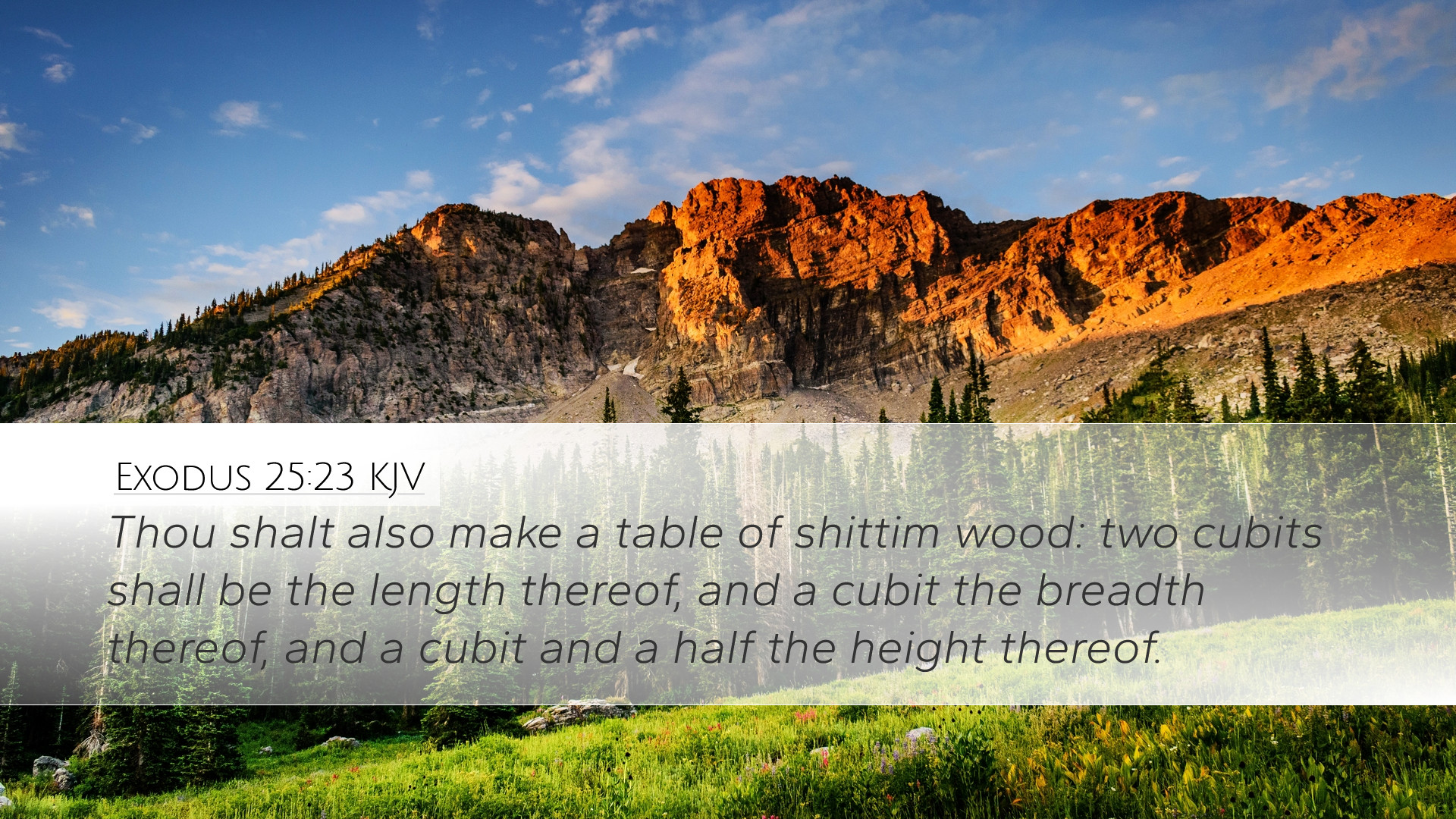Exodus 25:23 - Commentary
Exodus 25:23 states: "You shall make a table of acacia wood. Its length shall be two cubits, its width a cubit, and its height a cubit and a half." This verse introduces the specifications for the table which was to be used in the tabernacle, an important element of ancient Israelite worship. In this commentary, we explore insights from various public domain commentaries to provide a deeper understanding of this significant biblical passage.
1. Historical Context
The context of Exodus 25 is rooted in the broader narrative of the Israelites' journey toward the Promised Land. Having escaped slavery in Egypt, they are now tasked with establishing their identity as God's chosen people through worship. The instructions for the tabernacle, beginning in this chapter, reflect God's desire to dwell among His people.
Matthew Henry's Insights
Matthew Henry emphasizes the importance of the tabernacle as a symbol of God's presence. He notes that the table, along with the other furnishings of the tabernacle, was designed for practical use but also carried deep spiritual meaning. The acacia wood used signifies durability and resistance to decay, symbolizing the eternal nature of God’s covenant.
Albert Barnes' Observations
Albert Barnes provides meticulous details about the measurements and materials specified in Exodus 25:23. He points out that the use of acacia wood demonstrates divine choices in construction, reflecting both practicality and a richness in symbolism. The dimensions given (two cubits in length, one cubit in width, and one and a half cubits in height) suggest a table that is both substantial and proportionate, fitting for a sacred space.
Adam Clarke's Interpretation
Adam Clarke highlights the role of the table in sustaining the bread of the Presence, which will be elaborated on in later verses. According to Clarke, this bread represented fellowship between God and His people. The table's construction serves to facilitate this communion, symbolizing the nourishment of spiritual life that God provides. The physical table thus becomes a metaphor for the sustenance found in a relationship with God.
2. Theological Significance
This passage reveals important theological truths that extend beyond the physical aspects of the table. The instruction to make a table signifies God's desire for fellowship and communion with humanity, a theme that recurs throughout Scripture.
- God's Presence: The table becomes a focal point of God's presence among His people, illustrating the idea that God longs to be reconciled with humanity.
- Communion and Fellowship: The table holds the bread of the Presence, emphasizing the concept of ongoing communion with God. This foreshadows the Eucharistic themes in the New Testament, where Christ is presented as the ultimate sustenance.
- Divine Order: The meticulous nature of the specifications demonstrates God's desire for order and holiness in worship, suggesting that all aspects of worship should reflect His character.
3. Practical Applications for Leaders
For pastors and church leaders, the insights from Exodus 25:23 can bear practical implications for contemporary ministry:
- Design of Worship Spaces: Just as the table was a designated place for sacred elements, church designs today should provide spaces that facilitate connection with God and community.
- Emphasis on Sacramental Life: The Scriptures remind leaders of the ongoing necessity for sacramental moments within worship, prioritizing the sharing of bread and fellowship, akin to the bread of the Presence.
- Teaching about Divine Provision: Just as the Israelites were reminded of God's provision through the bread on the table, leaders are called to teach their congregations about reliance on God's daily sustenance.
4. Conclusion
The specifications for the table in Exodus 25:23 are imbued with rich theological significance and practical implications. Through the insights gathered from Matthew Henry, Albert Barnes, and Adam Clarke, we see that this seemingly simple piece of furniture provides profound insights into the nature of God’s presence, our need for communion, and the importance of maintaining holiness in worship. As we reflect on these truths, may we be inspired to create spaces of worship that testify to God’s enduring commitment to His people and encourage rich fellowship with Him.


